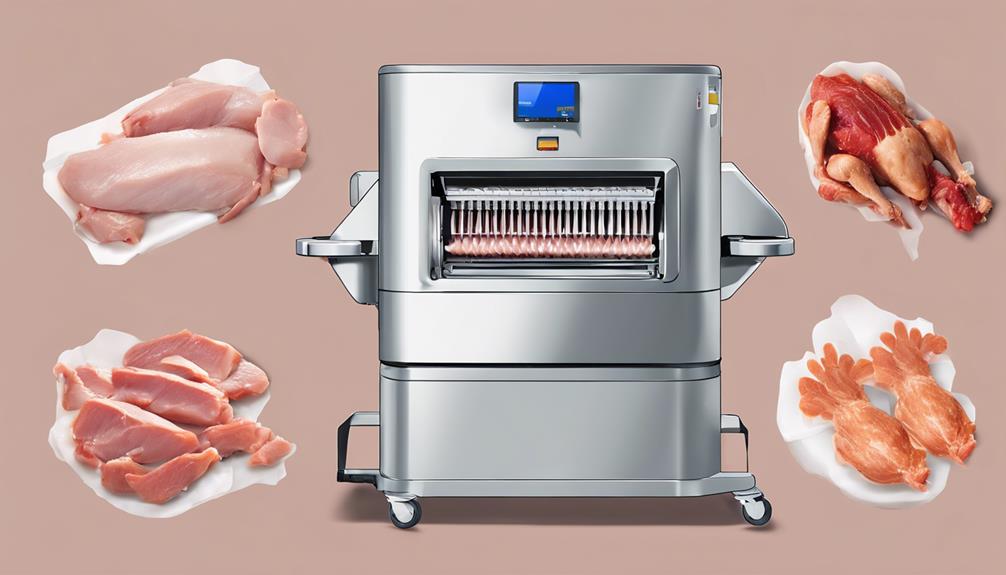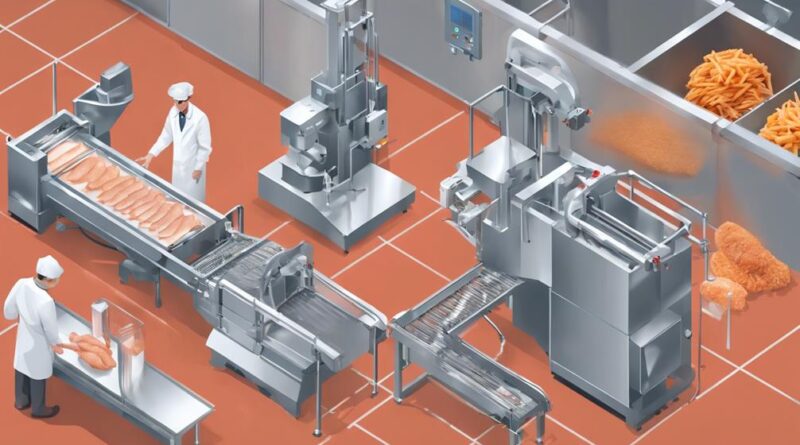Top Innovations in Chicken Product Processing Technology"
Explore how top innovations in chicken product processing technology are reshaping the poultry industry. From automation streamlining the slaughtering process to advanced deboning techniques and state-of-the-art antibacterial treatments, these advancements are revolutionizing efficiency and quality control. Discover how cutting-edge packaging solutions and product traceability systems are ensuring food safety and meeting consumer demands for high-quality chicken products. Stay tuned to uncover how these innovations are not just changing the way chicken products are processed but also how they are delivered to consumers.
Automation in Slaughtering Process
In modern chicken product processing, the integration of automated systems has revolutionized the slaughtering process, enhancing efficiency and precision to meet industry demands.
Automated carcass handling involves the use of advanced machinery to streamline the movement of chicken carcasses throughout the processing plant. These systems transport, position, and organize the carcasses with minimal human intervention, reducing contamination risks and ensuring a hygienic process. By automating this crucial aspect, companies can increase processing capacity while maintaining quality control standards.
Robotic evisceration is another groundbreaking technology that has improved the efficiency and accuracy of chicken processing. These systems are equipped with precision tools and sensors that can perform delicate tasks such as removing organs with unmatched consistency. Robotic evisceration works faster than human workers and is less prone to errors, resulting in higher yields and reduced downtime.
Advanced Chicken Deboning Techniques
Utilizing cutting-edge technology and precision machinery, advanced chicken deboning techniques have revolutionized the poultry processing industry. Robotic deboning systems have emerged as a game-changer, offering unmatched efficiency and accuracy in separating meat from bones. These systems are equipped with advanced sensors and algorithms that allow them to adapt to different chicken sizes and shapes, ensuring minimal waste and maximum yield.
One of the key innovations in advanced chicken deboning is the use of ultrasonic cutting technology. Ultrasonic blades vibrate at high frequencies, creating clean and precise cuts through the chicken meat and bone. This technology not only enhances the speed of the deboning process but also improves the overall quality of the meat by reducing tissue damage and contamination risks.
Robotic deboning combined with ultrasonic cutting has significantly increased productivity in chicken processing plants. The robotic systems can work tirelessly with consistent precision, reducing the need for manual labor and minimizing the risk of repetitive strain injuries among workers. Moreover, the integration of ultrasonic cutting technology ensures that the deboned chicken products meet high standards of quality and hygiene.
Cutting-Edge Poultry Packaging Solutions
Employing state-of-the-art materials and design, poultry packaging solutions have undergone a transformative evolution in ensuring freshness and extending shelf life for chicken products. Sustainable packaging has become a key focus in the poultry industry, with a shift towards using recyclable materials that reduce environmental impact.
Innovative packaging solutions now incorporate sustainable practices by utilizing materials that can be easily recycled. This not only benefits the environment but also aligns with consumer preferences for eco-friendly products. Manufacturers are investing in research and development to create packaging that meets stringent sustainability standards without compromising on functionality.
One cutting-edge approach involves the use of biodegradable films and compostable trays made from plant-based materials. These materials provide the necessary barrier properties to maintain product freshness while being environmentally friendly. Additionally, advancements in modified atmosphere packaging technology help in extending the shelf life of chicken products by controlling the internal atmosphere of the package.
High-Tech Chicken Grading Systems
The evolution of poultry packaging solutions towards sustainability has paved the way for advancements in high-tech chicken grading systems. Robotic grading and computerized sorting have revolutionized the chicken processing industry, ensuring efficiency and accuracy in quality control.
Robotic grading systems utilize advanced sensors and artificial intelligence algorithms to assess various attributes of chicken products, such as size, weight, color, and texture. These systems can process a high volume of chickens rapidly, providing consistent and precise grading results. By automating the grading process, companies can improve productivity, reduce labor costs, and enhance overall product quality.
Computerized sorting technologies further enhance the efficiency of chicken grading systems by categorizing products based on predetermined criteria. These systems can segregate chickens according to their grades, ensuring that each product meets specific quality standards. By streamlining the sorting process, companies can minimize errors and optimize the utilization of resources.
Innovative Chicken Washing Technologies
Cutting-edge chicken processing facilities have embraced revolutionary washing technologies to enhance food safety and quality standards. Among these innovations, waterless sanitizing and ultrasonic cleaning have emerged as key players in the quest for more efficient and effective chicken washing processes.
Waterless sanitizing systems use advanced technologies such as ozone treatment or antimicrobial sprays to eliminate bacteria and pathogens from the surface of chicken products without the need for water. This method not only conserves water but also minimizes the risk of cross-contamination, ensuring a higher level of food safety throughout the processing line. By reducing the reliance on water, facilities can also streamline their operations and decrease overall water consumption, making it a more sustainable choice for chicken processing plants.
Ultrasonic cleaning technology utilizes high-frequency sound waves to agitate a cleaning solution, creating microscopic bubbles that effectively scrub the surface of chicken products. This method offers a thorough and gentle cleaning process that can reach crevices and hard-to-reach areas, ensuring that contaminants are removed without damaging the chicken. Ultrasonic cleaning is particularly useful for delicate chicken products or intricate parts of processing equipment that require a precise and efficient cleaning method.
Incorporating waterless sanitizing and ultrasonic cleaning technologies into chicken processing operations represents a significant leap forward in improving food safety, quality, and sustainability standards within the industry. By implementing these innovative washing technologies, facilities can enhance their processes, reduce water usage, and ultimately deliver safer and higher-quality chicken products to consumers.
State-of-the-Art Antibacterial Treatments
Implementing advanced antibacterial treatments is crucial for enhancing food safety standards in chicken product processing. Antibacterial coatings have emerged as a state-of-the-art solution to combat harmful bacteria on the surface of chicken products. These coatings are designed to inhibit the growth of pathogens, ensuring the microbiological safety of the final product. By applying antibacterial coatings during processing, manufacturers can significantly reduce the risk of contamination and improve overall product quality.
Ultraviolet (UV) disinfection is another cutting-edge technology that plays a key role in antibacterial treatments for chicken products. UV light effectively destroys the DNA of bacteria, viruses, and other pathogens, preventing their proliferation. This non-chemical method is highly efficient and environmentally friendly, making it a preferred choice for many processing facilities. By incorporating UV disinfection systems into processing lines, companies can achieve a higher level of microbial control and ensure the safety of their chicken products.
Enhanced Chicken Meat Tenderizing Methods

Introduce the latest advancements in chicken meat tenderizing methods with a focus on efficiency and quality, revolutionizing the processing industry.
Mechanical tenderizing has long been a staple in the poultry industry, but recent innovations have taken this process to new heights. Advanced mechanical tenderizing machines now utilize cutting-edge technology to tenderize chicken meat more efficiently and effectively than ever before. These machines work by physically breaking down the muscle fibers in the meat, resulting in a more tender product that meets consumer demands for quality and taste.
In addition to mechanical tenderizing, enzymatic solutions have emerged as a game-changer in the quest for perfectly tender chicken meat. Enzymes are naturally occurring proteins that can break down tough muscle fibers, resulting in meat that's more tender and palatable. By incorporating enzymatic solutions into the tenderizing process, poultry processors can achieve consistent results and enhance the overall quality of their products.
Revolutionary Chicken Product Traceability Systems
With the evolution of technology, chicken processors are now integrating revolutionary traceability systems to enhance product monitoring and quality control. Supply chain tracking has become more efficient through the implementation of advanced digital labeling technologies. These systems allow for real-time monitoring of chicken products from the farm to the consumer, ensuring quality assurance at every step of the process.
Digital labeling plays a crucial role in enhancing consumer transparency by providing detailed information about the origin of the chicken product, processing methods, and expiration dates. By scanning a QR code or utilizing a smartphone app, consumers can access a wealth of information about the chicken they're purchasing, including details about the farm where it was raised and the journey it took to reach the store.
These traceability systems not only benefit consumers but also aid in improving internal quality control measures for chicken processors. By tracking each product throughout the supply chain, processors can quickly identify and address any issues that may arise, ensuring that only the highest quality chicken products make it to the market.
Frequently Asked Questions
How Are Chicken Product Processing Technologies Impacting the Environment?
Chicken product processing technologies are impacting the environment through various means. From reducing water usage to implementing energy-efficient machinery, sustainability measures are being integrated to minimize environmental impact.
Innovations like advanced waste management systems and eco-friendly packaging solutions are also being adopted. These technologies aim to streamline operations while prioritizing eco-conscious practices.
What Safety Measures Are in Place for Workers in These Processing Facilities?
To ensure worker protection in processing facilities, strict protocols are in place. Safety gear, regular training, and monitoring enhance occupational health. The focus on labor rights promotes workplace safety.
Innovations like automated machinery reduce physical strain, while ergonomic designs prioritize employee well-being. Continuous improvement and adherence to regulations contribute to a safer environment for workers in these processing facilities.
Are There Any Ethical Concerns Associated With These Innovative Technologies?
When considering the ethical implications of innovative technologies in chicken processing, it's crucial to assess how these advancements impact animal welfare, worker conditions, and environmental sustainability.
Consumer awareness plays a key role in driving industry standards towards more ethical practices. By prioritizing transparency and accountability, companies can address concerns and build trust with consumers.
Striking a balance between technological progress and ethical considerations is essential for the future of chicken product processing.
How Do These Advancements Affect the Nutritional Value of Chicken Products?
When it comes to processing technology and its impact on chicken products, you may wonder how these advancements affect the nutritional value. These innovations can actually enhance the nutritional benefits of chicken by improving processing methods that retain more nutrients.
Health implications of these changes include potentially providing consumers with more nutrient-dense options. Innovation's impact on chicken products may lead to healthier choices for those seeking balanced diets.
What Are the Future Trends in Chicken Product Processing Technology?
In the future, automation efficiency will drive advancements in chicken product processing technology. Robotics integration will streamline operations, improving speed and accuracy.
Quality control measures will become more stringent, ensuring consistent product quality. Traceability advancements will enhance food safety protocols, allowing for better tracking of products throughout the supply chain.
These trends will revolutionize the poultry industry, making processing more efficient, precise, and reliable.
Conclusion
You have now explored the top innovations in chicken product processing technology, from automated slaughtering processes to advanced deboning techniques and state-of-the-art packaging solutions.
These advancements are revolutionizing the poultry industry by enhancing efficiency, accuracy, and quality control. With cutting-edge grading systems, innovative washing technologies, and product traceability systems, the future of chicken processing looks bright.
Stay tuned for more groundbreaking developments in this ever-evolving field.
